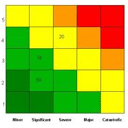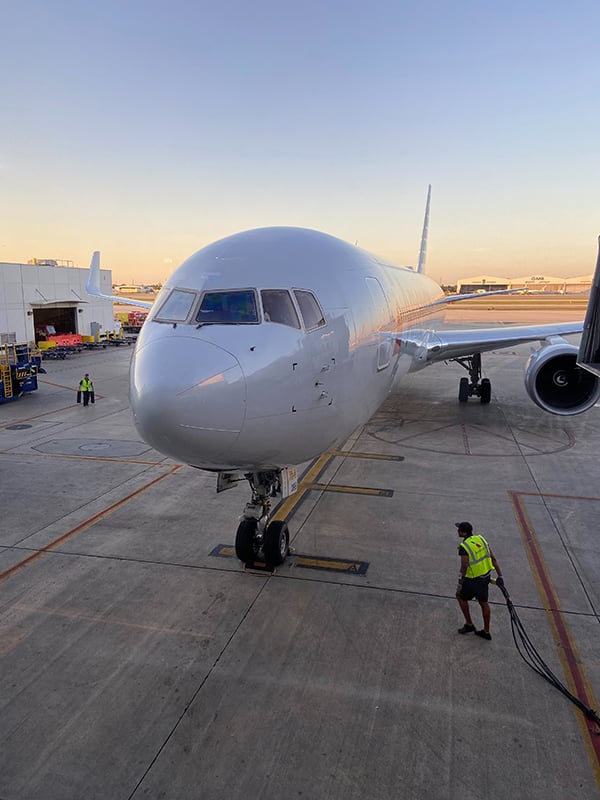Do We Need an Aviation Safety Database Yet?

Not every aviation safety manager has a budget. Let's face it. Some safety managers don't know how to ask for a budget.
Many safety managers are part-time safety managers. These are line employees with full-time duties in the position they were formally hired to fill. This may be their first time being exposed to aviation safety management systems (SMS).
Other safety managers are too intimidated to ask for a budget, believing that not being able to "figure it out yourself" is either a sign of:
- weakness and incompetence; or
- not knowing what in the hell you are doing.
Related Aviation Safety Manager Articles
- Career Advice for Aspiring Aviation Safety Managers
- 5 Habits of Highly Effective Aviation Safety Managers
- 5 Times Documentation Saves Safety Managers in Aviation SMS
Accountable executives and top-level managers think little of paying $4,000+ to fuel up the company jet, but spend $300 a month for safety software? Are you kidding? "How does that add value to our operations?" they may ask.
- "Can't we just have employees report safety concerns by email and store the safety reports in a spreadsheet?"
- "Why do we need a database? We have a small, simple operation."
- "We can't afford more safety. We only need to comply with regulations, so we'll do the bare minimum."
This is short-sighted thinking or these managers don't understand the objective of an aviation SMS. It may be true that production capabilities or market conditions do not allow for additional discretionary spending. Yet in the grand scheme of things, the SMS database acquisition is considerably less expensive than hiring an additional employee to manage the SMS documentation requirements.
There are times when you cannot simply go out and purchase an SMS database with the accompanying risk management workflows. For example, there may be data security considerations. Some operators exist in unstable political regions. Having SMS data reside on servers in a foreign country may not be possible due to economic sanctions or the risk of severing ties with the country hosting the servers where SMS data is stored.
Yet in most cases, management either:
- doesn't understand the objective of SMS; or
- are not familiar with the extensive SMS documentation requirements.
Many old-school managers may believe the SMS is another way for the government to control or monitor private industry. This is not the case. For those of us operating in the aviation industry for even a short ten-year period, we have repeatedly seen the many preventable minor incidents and close calls that plague the aviation industry.
The FAA eloquently states that the objective of aviation SMS is to:
- proactively manage safety,
- identify potential hazards,
- determine risk, and
- implement measures that mitigate the risk.
The FAA envisions operators being able to use all of the components of SMS to enhance a carrier’s ability to identify safety issues and spot trends before they result in a near-miss, incident, or accident. For this reason, the FAA is requiring carriers to develop and implement an SMS. (emphasis and formatting added).
Source: Federal Register / Vol. 80, No. 5 / Thursday, January 8, 2015 / Rules and Regulations
In order to "identify safety issues," employees will need to be trained in hazard identification and safety reporting processes. Likewise, to "spot trends," the organization will need to develop SMS data management strategies that facilitate the collection, aggregation, and analysis of SMS data to detect these trends over many years.
Related Aviation SMS Trend Analysis Articles
- How to Use Trending Charts in Aviation SMS
- How to Prepare Data for Trend Analysis in Risk Management Programs
- Six Steps How to Perform Trend Analysis in Aviation SMS
Presenting Your Case for a Safety Database

Let's face it, the majority of "new safety" managers were not at the feeding trough when department managers were squabbling over the budget. In this case, you may have to wait for the next budget cycle and hope for the best. Make sure you are armed with a short, prepared list of benefits that can be achieved by using an aviation safety database.
When discussing benefits, be sure you focus on benefits to the organization, and not so much on labor-saving efficiencies in the safety department. When safety teams complain about too much work in their department, they come off as sounding like "whiners." Remember, the value that safety brings to the company is not self-evident. How does the safety team save the company money related to:
- prevented accidents;
- lost time injuries;
- regulatory fines; or
- spotting inefficient operating practices?
When making your case, you shouldn't stop yourself short with just the safety database. Get an entire software package, as aviation SMS software is not very expensive compared to the accuracy it provides and the labor it replaces. You had also better be prepared to discuss the benefits of aviation SMS software before presenting your case, such as
- automated workflows,
- email notifications,
- automated escalation for overdue tasks; and
- enhanced SMS performance monitoring capabilities.
If you don't understand the difference between an SMS database and SMS software, you may need to educate yourself. A database provides a framework to:
- collect data;
- store data; and
- retrieve data.
SMS software can be thought of as the "brains" behind presenting the data to end-users to facilitate fact-based decision-making processes.
The database is the data storage piece. Most of the intelligence that safety managers need does not live in the database. SMS software manipulates data and presents the data to end-users to accomplish their immediate objectives. This is important to understand. For example, a database, by itself cannot make charts and graphs. Another software program is required to take the data set from the database and convert it into the desired charts, such as an SMS performance monitoring dashboard.
Not all SMS databases are created equal. Some are very basic and rudimentary, while others are considerably more advanced and are the data sources upon which the SMS software depends. For example, some databases are connected to powerful SMS software that is capable of identifying trends automatically and sending email notifications when trends are detected. Other databases are simply glorified spreadsheets in the cloud that offer few or very basic analytical tools upon which to base risk management decisions.
The key point is that SMS Database does not always mean SMS Software. They are not the same. Yet laymen have come to expect SMS software to come with the acquisition of an SMS database.
Be prepared to be denied requests for SMS databases or SMS software. "Old school" managers didn't need databases, so why should you need one?
Related Aviation SMS Software Articles
- 20 Benefits of Aviation SMS Software
- How to Choose Aviation SMS Software - Educating SMS Professionals
- How Does Aviation Safety Software Improve Safety?
Who Led Aviation Safety Managers Astray - Offering False Hope
For years, trustworthy aviation safety consultants have been telling operators that you don't really need an aviation safety database. And then these same aviation professionals leave their clients holding a few Word templates and an Excel spreadsheet.
Everyone is happy. Consultants are happy because they got paid and left their clients with "something." Managers are happy because they received training and tools that really didn't adversely affect operations. In short, when the consultants leave, everyone goes back to business as before. Nothing changes. Is that what you paid for? "No change?"
So, this is not the fault of these safety managers who hired the safety consultants. Nor is this the fault of the aviation safety consultants. "Aviation safety consultant" means that these folks are knowledgeable about "aviation safety," not "aviation safety databases." Most of the older generation consultants are intimidated by the word, "database." Little wonder that safety consultants seldom advocated for technology that they were not familiar with.
Not every company needs an SMS database. A quick rule of thumb is that if your company has fewer than 40 employees and little employee turnover, then you can manage the SMS using spreadsheets, email, and paper. Otherwise, if you have an unstable workforce, an SMS database offers continuity of the SMS once the safety department leaves.
Another consideration for smaller companies deciding upon an SMS database is how much time the safety manager has available to manage SMS documentation requirements. If you have a part-time safety manager with a full-time pilot schedule, you will need an SMS database to make the part-time safety manager more effective.
MANY smaller aviation service providers appoint an office worker as the safety manager. Based on empirical evidence, I would say this happens about 5% of the time. There are legitimate reasons why an aviation safety manager does not need operational experience to manage the SMS. Furthermore, there are reasons why this office person will be more effective in managing SMS documentation requirements than pulling a line pilot aside and saddling already overworked employees with the additional duties required of safety managers.
But how does this look to auditors? Is it professional? How will this affect safety culture?
Should the safety manager be required to have operational experience?
The jury is still out, but many aviation service providers operate in remote areas where the availability of qualified safety managers is extremely limited. In these cases, there becomes little alternative. Having an office administrator act as the safety manager may not be the accountable executive's first choice, but it may be the only choice. Additional factors may be at play here, such as:
- No qualified alternate employee with free time in operations;
- Operator only needs a "paper SMS" or "check-the-box" SMS; or
- No funds available to support a qualified safety manager.
Related Aviation Safety Manager Articles
- Why/When Aviation Safety Managers Don't Need Operational Experience
- What Is an Aviation Safety Manager in SMS?
- How to Tell If Aviation Safety Manager Is Doing Their Job
Why Should I Believe You About Aviation Safety Databases?
If you want an authoritative answer on whether you need a safety database to manage the aviation SMS requirements, ask the Canadians and the Australians. These two groups are the furthest along in their SMS implementations.
From experience, we have seen hundreds of operators try to manage their aviation safety data using Word templates and Excel files. The majority of these aviation service providers developed in-house solutions, doing the best that they could.

Their systems were a compilation of:
- Home-grown MS Access databases;
- MS Word files;
- SharePoint content management systems;
- MS Excel files; and
- Paper.
Now, these operators are migrating to professionally designed aviation safety databases. They learned the hard way.
As long as the original safety manager stays with the company, everything will work fairly smoothly. But when the safety manager retires or gets hit by the bus, then management realizes that they have a problem with figuring out how this "system" really works.
SMS is a system, and safety promotion is the most neglected component when the safety team turns over. When a new safety manager takes over an existing SMS, it becomes very difficult to learn where all the SMS data exists when it is strung across six different systems. What systems are we talking about?
- Safety reporting system;
- Risk management system (treatment of reported safety issues);
- Auditing system;
- SMS training system;
- Hazard/risk register;
- Management of Change system;
- Emergency Response Plan Management system; and
- Document management system.
There are a lot of SMS documentation requirements that span multiple, disparate systems. And you are probably monitoring multiple other systems that affect operations. Take my word for it, SMS data management can become challenging after year three of the SMS implementation. Why do I say "year three" is when you may start to experience problems?
Year three in your SMS implementation is important in that SMS auditors have higher expectations from your SMS. By year three, you should have a fully implemented SMS. Auditors will want to see training records and evidence that you have the capability to monitor hazards and risk controls.
Related Articles on Aviation SMS Auditing
- How to Create an Aviation SMS Audit Plan
- Audit Checklist: 10 Things to Prepare for Aviation SMS Audits
- Real Difference Between an Aviation Safety Audit vs. Inspection
Which SMS Implementation Phase to Adopt SMS Database?

Do you know where you are in your SMS implementation? Do you really know which phase of your SMS implementation you are currently in now? It is easier to move into a new SMS database in implementation phases one and two. There will be less data migration and "re-training" when moving to the SMS database in the earlier years.
To check which phase you are in, below are four sample surveys to evaluate your SMS. These are confidential and only you see this data.
- Phase 1 SMS Implementation Survey
- Phase 2 SMS Implementation Survey
- Phase 3 SMS Implementation Survey
- Phase 4 SMS Implementation Survey
In regions with inconsistent regulatory oversight, you may get by for five to eight years before auditors exert enough pressure for operators to consider SMS data management change. Other factors that may cause this timeline to change are:
- size and complexity of the organization; and
- industry segment (airlines and airports/aerodromes are heavily monitored).
All Aviation Service Providers Use Databases for Aviation Safety
Yeah, right, I say sarcastically. The smart ones are using databases and the ones that can get budget, and acquire safety databases designed specifically for the aviation industry.
Not all safety managers have the ability to purchase a "commercial-off-the-shelf" (COTS) database solution. Therefore, I cannot say all operators are using databases yet for aviation safety needs. This would be a universal statement, and as you know, most universal statements are ripe to be torn apart.
Not all operators are jumping up and saying, "All my safety data needs to go into a database." The exceptions are the very small operators with fewer than ten employees. These are cases where it may be overkill. These operators may have one or two issues per year. Communication is often face-to-face. These operators could use Word and Excel.
The very large airlines, airports, and maintenance providers are using databases that they either built in-house or adapted from the quality management systems. Operators that have over 60 employees should definitely use an SMS database. The SMS database is more than hazard reporting, as you should know by now if you have conducted a gap analysis. SMS documentation requirements run very deep and across multiple systems.
Final Thoughts on Designing Your Own Database
When the bad news comes that management won't support your budget for a safety database, it is time to build your own. As I said, smart, well-educated safety managers are the norm, not the exception. Most aviation safety managers have exceptional computer skills.
Just as the Canadians and Australians designed their own systems in the early years, so can you. In a future article, I will give you instructions on how to create a simple safety database that any aviation service provider can use. Don't lose hope. Keep it simple for the first couple of years and hopefully, your safety department will get its share of the budget in the coming year or two.
If you are operating under the EASA jurisdiction, you will not be able to store your mandatory reportable occurrences in a spreadsheet. You will need a database per EASA Regulation 376/2014. Good luck.
Learn how a safety database can be used in all four phases of an aviation SMS implementation. These short demo videos show how you can benefit from a low-cost, commercially available SMS database.
Live SMS Pro Demo
Have questions about SMS Pro? Want to see a live demo of SMS Pro? Sign up below:
Last updated December 2025.







